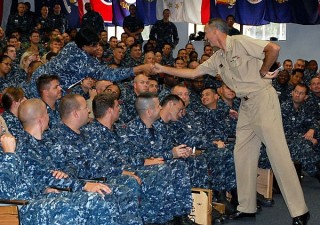
The Navy’s personnel chief says the service has been making steady progress in reducing the 10,000 skill-set gaps between sea and shore billets by incentivizing people “to return to sea” and increasing the recruiting mission in undermanned ratings.
Vice Adm. Scott Van Buskirk, speaking on 9 April at the Navy League’s Sea-Air-Space Exposition 2013 at National Harbor, Md., said 7,000 gaps at sea remain and asked the Fleet “to be patient” as the recruits move through the schoolhouse. “We still have to do some cross-decking” to keep the appropriately rated sailors on board ships.
Among the reasons for the gap: earlier ship-manning decisions, especially for aircraft carriers, “took too much risk” in cutting the number of sailors assigned to a ship, he said. “In addition, a lot has to do with changes in mission sets that require a different work force.”
A bright spot in manning exists in crews for forward-deployed ships. Van Buskirk reported the Navy doesn’t have gaps filling those ships. Working with host governments, such as Spain, for ships assigned to Rota, the Navy can man the ships by rotating crews in and out or allowing sailors to take their families with them and the local economy can support them. “The footprint differs from one place to another.”
Looking at recruiting in critical career fields, Van Buskirk said the Navy has had to “work very hard at nuclear ratings . . . medical professionals, and [faces] challenges in IT” (information technology). In answer to a question, he said the demand for cyberwarriors (IT) has risen dramatically. “We’re adjusting our schoolhouses so we can get more throughput” to meet the demand. He added, “The key is, will we be able to do that as the economy changes? It’s probably going to get harder.” To help recruit those sailors in the future, the Navy will look at “more bonuses and better packages to get people in.”
One area where “throughput” will be affected by the $4 billion shortfall in the Navy’s operations and maintenance accounts is the use of mobile training teams as furloughs of civilian employees begin. Van Buskirk said he did not anticipate that the furloughs expected to begin this month will affect graduation dates at the Naval Academy and the Naval Postgraduate School. “We are adjusting our schedules to keep graduation on time.”
Van Buskirk said that the Navy intends to support family programs and child-care, but did not acknowledge that furloughs could affect housing. The shortfall’s impact probably will be more noticeable in buildings, he said. “When things break, we may not be able to fix that” as quickly. A key question, he said, is “can we catch up in the future?”





